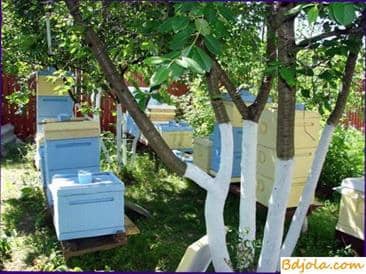
In the attic of the country house I equipped a warmed pavilion with an area of 6 m2, in which I keep four families of bees. Hives are multi-hull, each consists of two nesting and two honey hulls. Doña are equipped with retractable metal pallets, above which are mesh subframes. The cases are mounted on stands 120 mm high, which serve as an “air cushion” all year round.
Nest cases are made of boards with thickness of 20 mm, and honey ones – from plywood. Reducing the mass of the bodies allowed increasing their volume. Each includes 12 frames of Langstroth-Ruta with a reduced (up to 10 mm) thickness of the upper bar. When the hive consists of four buildings, 48 honeycombs are placed in it, equal in area to 50 cells with a top plate 20 mm thick.
The hives have only lower flanges (400X20 mm) in the stand, and are installed close to the wall of the pavilion 120 mm thick. In it are cut windows for flaps measuring 400X60 mm, and outside are installed landing boards 450X300 mm. Thus, bees with fully open windows during an abundant bribe can fly right up to the tap. On the hives I place orgalitic ceilings with a hole for the passage of bees to the trough and 120 mm high roofs with a 20 mm board roof. The bees hibernate regardless of their strength (but not weaker than the six-lane lines) in the two nested buildings. Frames set on a cold skid.
In the first decade of August, after the bribe, I begin to select the honey corps. Two days before that, I set up a diaphragm ceiling with two bee removers for them (to increase the capacity).
Of the two nest cases, the extra frame I select. I reduce the nests to nine or ten honeycombs in each case for strong families and up to seven for layering. In the lower housing I transfer all frames with brood, small-copper light-brown and two pergone frames I put along the edges. In the upper case I place honeycombs, half or three-fourths full with honey and perga. In the winter, strong families leave 15-18, and 10-12 kg of honey for laying. For feeding on the ceiling I put a feeder. The beehive is covered with a roof with a hole for pouring the syrup. I reduce the summer to 5 cm.
For three weeks I feed bees with sugar syrup (1: 1), one to two liters a day before the honeycomb filling of the upper shell. Bottles get 8 kg of sugar, and the main family-15 kg, because at the end of summer there is heath bribe. In the syrup I add the preparation KAS-81 for the destruction of the tick.
In cold weather, the pavilion is heated by an electric heater with a power of 150 W, which raises the room temperature by 7-8 њ C compared to the outdoor one. It is desirable that during feeding and autumn growth of bees, the temperature in the pavilion does not drop below 20-22 њ C. If this temperature is maintained in the pavilion, the bees wear out on the processing of the syrup and the brood rearing. In the event that I can not feed bees regularly, I give them syrup in large portions (up to four liters), but less often, to finish top dressing at the same time. Under such conditions, the young uterus lays eggs well, and in the beginning of September, there are three to five frames of the sealed brood in the main families. Protein dressing in August, I give only in bad weather, because in the days of fine bees we still bring a lot of pollen.
In the second decade of October, when you can no longer count on a natural flyby of bees, I call it artificially. At a temperature of 1.0-12 њ C in quiet sunny weather, I warm up the pavilion to 20-22 њ C. In the ceiling holes I put inverted jars of syrup, tied with gauze. Bees, as a rule, amicably oblyayutsya.
In late November – early December, when stable frosty weather is established with a temperature of about 3-5 њ C below zero, the windows in the pavilion wall are filled with foam rubber and covered with a board. For air circulation, I leave only the internal ventilation openings located in the rear bar of the pallet under the net. On the ceiling I put a warming cushion, and in the hole above the free part of the housings I insert a polyethylene tube with a diameter of 25 mm. Its height is equal to the thickness of the pillow.
The free part of the buildings in the main families does not fill out anything. In hives with layers I establish a diaphragm in height in two cases, which fences the honeycombs of both bodies. To prevent the bees from leaving the pavilion through the tube, the upper end is tied with gauze. In the pavilion I turn on the heater, raising the temperature by 7 њ C. The hives on the outside are insulated.
Prepared in this way for the winter bees do not require care until early March. When the temperature in the pavilion rises to 6-8 њ C, the heater switches off until the bees fly around.
Мед из женьшеня. Как чистить улей.
Pasechnye buildings